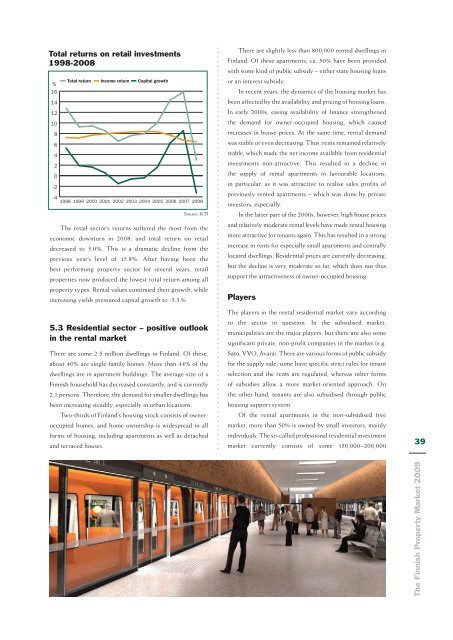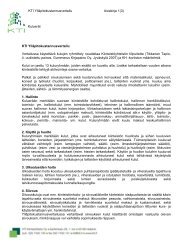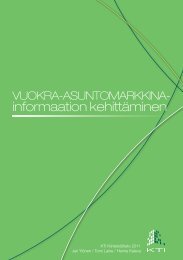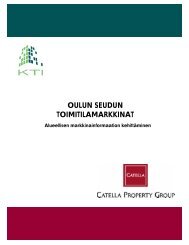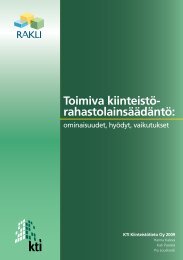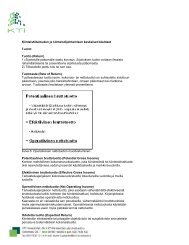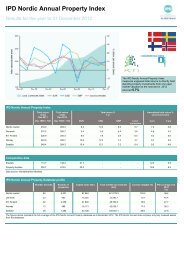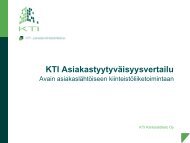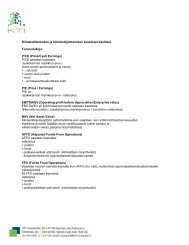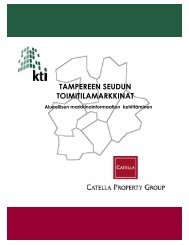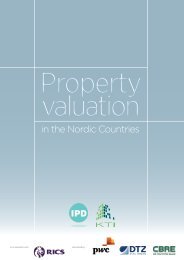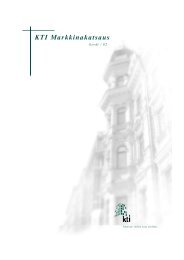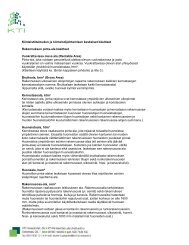The Finnish Property Market 2009 - KTI
The Finnish Property Market 2009 - KTI
The Finnish Property Market 2009 - KTI
Create successful ePaper yourself
Turn your PDF publications into a flip-book with our unique Google optimized e-Paper software.
Total returns on retail investments<br />
1998-2008<br />
%<br />
16<br />
14<br />
12<br />
10<br />
8<br />
6<br />
4<br />
2<br />
0<br />
-2<br />
Total return<br />
Income return<br />
Capital growth<br />
-4<br />
1998 1999 2000 2001 2002 2003 2004 2005 2006 2007 2008<br />
Source: <strong>KTI</strong><br />
<strong>The</strong> retail sector’s returns suffered the most from the<br />
economic downturn in 2008, and total return on retail<br />
decreased to 3.0%. This is a dramatic decline from the<br />
previous year’s level of 15.8%. After having been the<br />
best performing property sector for several years, retail<br />
properties now produced the lowest total return among all<br />
property types. Rental values continued their growth, while<br />
increasing yields pressured capital growth to -3.3.%<br />
5.3 Residential sector – positive outlook<br />
in the rental market<br />
<strong>The</strong>re are some 2.5 million dwellings in Finland. Of these,<br />
about 40% are single-family homes. More than 44% of the<br />
dwellings are in apartment buildings. <strong>The</strong> average size of a<br />
<strong>Finnish</strong> household has decreased constantly, and is currently<br />
2.1 persons. <strong>The</strong>refore, the demand for smaller dwellings has<br />
been increasing steadily, especially in urban locations.<br />
Two-thirds of Finland’s housing stock consists of owneroccupied<br />
homes, and home ownership is widespread in all<br />
forms of housing, including apartments as well as detached<br />
and terraced houses.<br />
<strong>The</strong>re are slightly less than 800,000 rented dwellings in<br />
Finland. Of these apartments, ca. 50% have been provided<br />
with some kind of public subsidy – either state housing loans<br />
or an interest subsidy.<br />
In recent years, the dynamics of the housing market has<br />
been affected by the availability and pricing of housing loans.<br />
In early 2000s, easing availability of finance strengthened<br />
the demand for owner-occupied housing, which caused<br />
increases in house prices. At the same time, rental demand<br />
was stable or even decreasing. Thus, rents remained relatively<br />
stable, which made the net income available from residential<br />
investments non-attractive. This resulted in a decline in<br />
the supply of rental apartments in favourable locations,<br />
in particular, as it was attractive to realise sales profits of<br />
previously rented apartments – which was done by private<br />
investors, especially.<br />
In the latter part of the 2000s, however, high house prices<br />
and relatively moderate rental levels have made rental housing<br />
more attractive for tenants again. This has resulted in a strong<br />
increase in rents for especially small apartments and centrally<br />
located dwellings. Residential prices are currently decreasing,<br />
but the decline is very moderate so far, which does not thus<br />
support the attractiveness of owner-occupied housing.<br />
Players<br />
<strong>The</strong> players in the rental residential market vary according<br />
to the sector in question. In the subsidised market,<br />
municipalities are the major players, but there are also some<br />
significant private, non-profit companies in the market (e.g.<br />
Sato, VVO, Avara). <strong>The</strong>re are various forms of public subsidy<br />
for the supply side; some have specific strict rules for tenant<br />
selection and the rents are regulated, whereas other forms<br />
of subsidies allow a more market-oriented approach. On<br />
the other hand, tenants are also subsidised through public<br />
housing support system.<br />
Of the rental apartments in the non-subsidised free<br />
market, more than 50% is owned by small investors, mainly<br />
individuals. <strong>The</strong> so-called professional residential investment<br />
market currently consists of some 150,000–200,000<br />
39<br />
<strong>The</strong> <strong>Finnish</strong> <strong>Property</strong> <strong>Market</strong> <strong>2009</strong>


